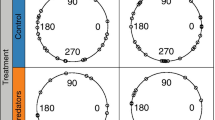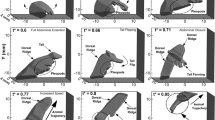Abstract
Fast-starts are distributed over a wide phylogenetic range of fish and are used for different purposes such as striking at prey or escaping from predators. Here we investigated 42 fast-starts of rainbow trouts (Oncorhynchus mykiss) elicited by a startle stimulus. We investigated the patterns of water movements left behind by the escaping fish and their possible value as a source of information to piscivorous predators that rely on hydrodynamic sensory systems. Particle image velocimetry (PIV) measurements revealed a temporal extension of up to 25.5 min and a spatial extension of up to 1.53 m (extrapolated) for a certain flow structure called jet 1, that is the flow produced by the tail fin. Duration and spatial extension of jet 2, the flow produced by the body, were on average lower, and both jets differed in size. The fish escaped in a mean direction approximately parallel to jet 1, and antiparallel to jet 2, with a range well above 200°. This study quantified the flow patterns generated by escaping fish and, as piscivorous predators would greatly benefit from being able to analyse these flow patterns, provides cues for the behavioural and physiological investigation of hydrodynamic sensory systems.






Similar content being viewed by others
References
Adrian RJ (1990) Engineering applications of particle image velocimeters. Proc SPIE Int Soc Opt Eng 1404:56–71
Agostinelli C, Lund U (2011) R package ‘circular’: Circular Statistics (version 0.4-3). https://r-forge.r-project.org/projects/circular/
Bleckmann H (1994) Reception of hydrodynamic stimuli in aquatic and semiaquatic animals. Gustav Fischer, Stuttgart, Jena, New York
Borazjani I, Sotiropoulos F, Tytell ED, Lauder GV (2012) Hydrodynamics of the bluegill sunfish C-start escape response: three-dimensional simulations and comparison with experimental data. J Exp Biol 215:671–684
Coombs S, Görner P, Münz H (1989) The mechanosensory lateral line. Neurobiology and evolution. Springer, New York, Berlin, Heidelberg, London
Dehnhardt G, Mauck B, Bleckmann H (1998) Seal whiskers detect water movements. Nature 394:235–236
Dehnhardt G, Mauck B, Hanke W, Bleckmann H (2001) Hydrodynamic trail following in harbor seals (Phoca vitulina). Science 293:102–104
Domenici P (2009) Escape responses in fish: kinematics, performance and behaviour. In: Domenici P, Kapoor BG (eds) Fish locomotion—an eco-ethological perspective. Science Publishers, Enfield
Domenici P (2010) Context-dependent variability in the components of fish escape response: integrating locomotor performance and behavior. J Exp Zool A Ecol Genet Physiol 313:59–79
Hanke W, Bleckmann H (2004) The hydrodynamic trails of Lepomis gibbosus (Centrarchidae), Colomesus psittacus (Tetraodontidae) and Thysochromis ansorgii (Cichlidae) measured with Scanning Particle Image Velocimetry. J Exp Biol 207:1585–1596
Hanke W, Brücker C, Bleckmann H (2000) The ageing of the low-frequency water disturbances caused by swimming goldfish and its possible relevance to prey detection. J Exp Biol 203:1193–1200
Jiang H, Kiørboe T (2011) Propulsion efficiency and imposed flow fields of a copepod jump. J Exp Biol 214:476–486
Mardia KV, Jupp PE (2000) Directional statistics. Wiley, Chichester, New York, Weinheim
Mogdans J, Nauroth IE (2011) The oscar, Astronotus ocellatus, detects and discriminates dipole stimuli with the lateral line system. J Comp Physiol A 197:959–968
Montgomery JC, Windsor S, Bassett D (2009) Behavior and physiology of mechanoreception: separating signal and noise. Integr Zool 4:3–12
Pohlmann K, Atema J, Breithaupt T (2004) The importance of the lateral line in nocturnal predation of piscivorous catfish. J Exp Biol 207:2971–2978
R Core Team (2012) R: A language and environment for statistical computing. R Foundation for Statistical Computing, Vienna. ISBN 3-900051-07-0, URL http://www.R-project.org/
Tytell ED, Lauder GV (2008) Hydrodynamics of the escape response in bluegill sunfish, Lepomis macrochirus. J Exp Biol 211:3359–3369
Vogel D, Bleckmann H (2000) Behavioral discrimination of water motions caused by moving objects. J Comp Physiol A 186:1107–1117
Webb PW (1976) Effect of size on fast-start performance of rainbow trout Salmo gairdneri and a consideration of piscivorous predator-prey interactions. J Exp Biol 65:157–177
Westerweel J (1997) Fundamentals of digital particle image velocimetry. Meas Sci Technol 8:1379–1392
Wieskotten S, Dehnhardt G, Mauck B, Miersch L, Hanke W (2010) Hydrodynamic determination of the moving direction of an artificial fin by a harbour seal (Phoca vitulina). J Exp Biol 213:2194–2200
Wieskotten S, Mauck B, Miersch L, Dehnhardt G, Hanke W (2011) Hydrodynamic discrimination of wakes caused by objects of different size or shape in a harbour seal (Phoca vitulina). J Exp Biol 214:1922–1930
Willert CE, Gharib M (1991) Digital particle image velocimetry. Exp Fluids 10:181–193
Wilson M, Acolas ML, Beacutegout ML, Madsen PT, Wahlberg M (2008) Allis shad (Alosa alosa) exhibit an intensity-graded behavioral response when exposed to ultrasound. J Acoust Soc Am 124:243–247
Acknowledgments
This study was supported by a grant of the German Research Foundation (DFG) to WH (Ha4411). We thank Guido Dehnhardt and the Sensory Ecology Group at Rostock University for providing laboratory space and for helpful discussions. Two anonymous reviewers provided highly valuable input. The experiments were carried out under the guidelines established by the European Communities Council Directive of 24 November 1986 (86/609/EEC).
Author information
Authors and Affiliations
Corresponding author
Electronic supplementary material
Below is the link to the electronic supplementary material.
Supplementary material 1 (WMV 4356 kb)
Supplementary material 2 (WMV 1598 kb)
Rights and permissions
About this article
Cite this article
Niesterok, B., Hanke, W. Hydrodynamic patterns from fast-starts in teleost fish and their possible relevance to predator–prey interactions. J Comp Physiol A 199, 139–149 (2013). https://doi.org/10.1007/s00359-012-0775-5
Received:
Revised:
Accepted:
Published:
Issue Date:
DOI: https://doi.org/10.1007/s00359-012-0775-5




